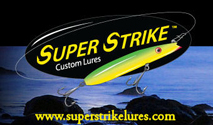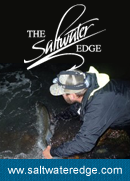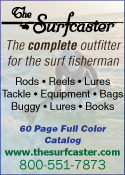I recived this email from a Blog reader Greg. I thought it was interesting enough to share with you all.
Zeno
Zeno,
I was checking my email after I closed up the shop today and couldn’t help send this email after reading all of the posts. This is really me rambling on. Hope you get a chance to read and maybe provide to your subscribers to read “for your information” or “food for thought”.
This piece of writing began after reading the SJ Blog post on October 3rd titled “Two Piece Rods”. A variety of comments were shared and some debated. Zeno posted a comment “No one sane can say they rather fish a two piece rods unless it’s a storage thing” and it sparked my writing because I would. Maybe I am not sane. I typed this up on Monday night and sent the following email to Zeno because I thought it was way too long to post. I am not an expert on rod blank construction but I wanted to shed some light on these new high tech and high performance rods:
Even if St. Croix made a one piece Legend, Century made a one piece Sling Shot, CTS made a one piece Vapor Trail or S8 (I think it is now available or soon will be)… I would still prefer the two piece blank. I might not be the majority but I have reasons why I love two piece rods and it isn’t for storage and travel although that is the major factor.
I own a variety of rods, too many (Century, CTS, Fenwick, G. Loomis, Lamiglas, St. Croix, among others) and actually love them all. Yes, I have many rods built on Lami GSB blanks from 7 through 12 foot. They do/did their job and kept asking for more. Sure I abused them over the years and a couple have broken. In the past two years these rods have begun to get dusty. Not because there is anything wrong with them but because there is more performance available at a great value.
First and more most, all rods will break if abused. Let’s remember that a fishing rod is a tool. We (anglers) present the lure and then (if good or just lucky )hook, fight and land the fish. And then do it all over again. As most know sometimes fishing demands the longest cast possible to reach outside the sandbar, a feeding school of fish, a rip or structure that is holding fish, etc. Because rods are held for long periods of time, the physical weight is import as well as sensitivity to feel the lure and the BITE. May the best tool for your job prevail.
[This paragraph is not fact, it is not proven, it is my opinion. ] I feel strongly that two piece rods are superior to one piece rods. A 60/40 (70/30 and even 50/50 style) two piece rod provides the angler with a stiff butt section that transfers the cast’s energy into the top section. I feel that this energy is lost in soft one piece rods. You can see it clear as day when watching one cast, when it bends right through the reel seat. Ok, there are parabolic rods designed for long distance casting that bend like a “c”; however, these rods have specially designed tapers which store and transfer the energy to the tip. These tapers are found on specialty rods, not your average fishing rod blank. I have found that my various two piece rods offer more sensitivity (quicker tapers- thinner tip diameter) and more fish steering control and leverage (stiff handle section). Also in most cases two piece blanks have much smaller butt diameters than comparable one piece rods. To me this I great because like fishing a 17 or 18 size reel seat much more than a 20, 22 or even larger.
Two piece rods are just as strong if not STRONGER! I cast to tuna (well over 100-lbs) with all two piece rods. As far as reported breakage? No offense, I would guess angler (like 95%+ of all breakages), high sticking or a nick in the blank (abuse). Yes I’ve seen plenty of broken rods (I work in a full service bait and tackle shop). A slim percent are actually a defect situation (blemish in the blank: wrinkle in the scrim, imperfections in material or resin, human error when sanding the blank) because most rod blanks are inspected (acid load test)before shipping out at the manufacturing facility. As far as a rod blank’s action power, line/lure weight and abs (absolute breaking strength)it all comes down to the blank’s design which incorporates it’s methods of construction, a combination of the blends of material, the amount of material (thickness) and the taper.
Fiberglass is cheap, heavy, slow but very durable. Graphite is more expensive, light, fast and fragile. Furthermore blanks with higher modulus graphite scrim equal a lighter, more responsive, more sensitive, faster action (more resistance to bend) rod. They also tend to feature thinner walls that are more prone to breakage from abuse; however, outperform glass rods. Please take note that there are many rods that fall in the middle between the two extremes. These rods are created with a blend of material glass and mid modulus graphite. For strength these fibers need resin and also resin needs fibers. In recent years 3M has taken a huge leap forward in resin technology, now offering super strong and super high performing resins which have been enhanced with nano-particles. These nano-resins have been formulated by 3M with nano-granule additives to allow blank building a world of opportunities, an amazing new strength to weight ratio possibilities.
Rod blank technology has changed a lot over the years and with it evolved more performance oriented rod blank design. For competitive reasons not all blank manufactures are willing to tell all about their blanks construction for competition purposes.
– Here in the USA St. Croix rods is at the forefront of rod building technology with their innovation, technology and machinery. Their proprietary technology such as their 3M nano resin (NSi – Nano Silica) [not used in the Legend Surf Series blanks] , continues tapers (IPC – Integrated Poly Curve Technology) and superior hoop strength (ART – Advanced Reinforcing Technology) are light years ahead (in terms of performance) of the blanks of yesterday.
– Across the Atlantic, Century rods (from the UK) is also at the forefront of rod blank technology. Century offers their autoclave technology, which is basically a climate controlled resin curing process. It eliminates impurities in the resin which makes for a stronger, more durable and longer lasting rod blank. The climate controlled process incorporates heat and pressure during the curing process to increase density and tensile strength . The finish product is a super slim diameter, light weight and a very crisp powerful rod. Part of Century’s cult following is because of their anti twist technology (ATT) which is achieved by their machined ferruls that ensure a perfect fit via raw carbon to raw carbon mate. Each male and female is unique and not universal. Century also has beautiful tapers (smooth and consistent) as well as great action for optimum fish fighting comfort and high performance casting. I am sure Mike at KM Custom Rods could shed some more light on his line of Century blanks.
– CTS (hailing from New Zealand) is at the leading edge of rod design. CTS rod blanks feature a unique 100% non woven fiber carbon helix core (single carbon spiral) which offers incredible power, response and strength yet super light weight. CTS offers (with help from computer aid) tapers without flat spots and optimum load transfer for amazing casting performance. CTS uses high quality carbon to optimize strength and weight. They also offer their rods with super strong internal high strength ferrules. I don’t know much about the fine details of how CTS works their magic other than what is displayed on their website. Maybe Rich at RH Custom Rods could add more information.
I highly suggest getting out and attending any of the casting day demos that are offered. Get your hands on one as soon as possible and give it a cast. I don’t think you’ll look back.
I hope most all know this but I have to add:
Anyone who claims that two piece rods suck because they tweak out of alignment… please learn how to properly put together a two piece rod. I see lots of angler just push the top and the bottom section together (-><-). There needs to be a twist.
1) Both the male and female side of the ferrule need to be clean; no sand, salt, blood, slim, etc. If dirty clean away (a q-tip or a test tube brush might be required for the female side). Always add a little bit of “nose grease” or better yet ferrule wax to the male side. Take care of your equipment and this step is a breeze.
2) Align the rod’s top half guides at about 45 degree to perfect alignment (0 degrees) and then slide the two sections together and twist 45 degrees to seat and align in one movement. A slight degree or two will not make a difference. If the guides are 5-10degree “out of wack” redo.
3) TWIST and lightly pull to take apart. If hands slip use a rubber jar opener grip or that perforated material which is used to line cabinets. If need be, acquire a helper and twist in opposite directions. Don’t ever grab a guide for extra grip.
Hope you enjoyed the read… now let’s go fishing. It’s prime time!












If I never casted the tip section off, and if I never had to stop in the middle of fishing to re-align the sections, I would agree.
↓Greg, thanks for taking the time to share.
I found your instructions on how to assemble a two piece rod to be informative. Always learning something.
—
↓Dave
And if you can’t get them apart wait until winter. For some reason mine come right apart in Janurary.
↓to be honest alwas use a one piece rod i guess it was prefernce but came to realize that there isnt much of a difference at least i dont c it either way the rod dont catch the fish the angler does
↓I have to agree. It’s all in the assembly of your rod that makes it stay put when you use it. And if that doesn’t work, there is always adding a bit of electrical tape that will hold it in place for the time you use it.
↓Either way 2 piece rods are every bit of everything 1 piece rods are and more.
I should mention one thing, something that seems to me almost everyone is missing….my whole point of bringing this for discussion is not to compare one to two piece rods. I will never, ever believe that one piece is not superior. Maybe because I never fished with anything less till now. My point is this…no one makes the rods like (St,Croix, CTS,GLomis) in one piece configuration. I am sure if someone did, we’d all buy it.
↓“My point is this…no one makes the rods like (St,Croix, CTS,GLomis) in one piece configuration. I am sure if someone did, we’d all buy it.”
Would you? One thing that has not been addressed is what will the weight be of the one piece blanks. The CTS S8 proto blank that I have handled is a little over 3oz. heavier than the 2 pc. So now you have a blank in the weight range of a GSB, or maybe heavier. Something to think about!!
↓It’s not how many pieces of blank you have it’s how you use it lol.
↓The above posters make a good point, make sure you seat the two sections together properly,it’s not just push down and your done, if you seat them properly they will not need realignment mine never do and i take them apart every trip.
and theres a reason why you never assemble a two piece on the beach. One last thing 3M’s nano resin is not proprietary to St.Croix and St.Croix also uses computer aided design practices.
↓CTS one piece blanks are out being field tested now and will be on the market after the first of the year, 3 9′ models 3 10′ models and 2 11′ models,yes the one piece models are heavier than the 2 pc. models, there is no way around it due to the constant tapper from butt to tip, so you have a higher carbon content resulting in a “heavier blank” but it is not 3 oz. on the 9′ models it is between 1/2 to 3/4 oz. depending on the models . the 10′ it is 5/8 to 1 oz. and the 11′ is 3/4 to 1 oz.
↓its the industry pushing the two-piece rod not the fisherman or rod builders. thats how the blanks come. why would anyone want a 2 piece rod except for travel on a plane. marketing. if they hook up zeno w a computer like they do at the golf place to check out ur swing w a one piece & a 2 piece it would be interesting to see the computers results
↓I’m not a rod expert at all. Since I’ve been fishing and I can say that now it’s been a LOOONG time,I have used only two rods in the surf.My main rods have been one piece Lamis and I used a 10’Gutts Buster Shaksphere rod made strickly for fishing redfins made by Johnny Kronick’s shop and that’s it!!!.Well over time my back started to bother me and my casting style forced me to make some changes.I read about new technology in rods and how light weight,responsive and powerful these new rods are,the only thing I did’nt like was they are two piece.So now to the point. I tested the rod I belived would fill my needs as to weight,distance and something that wouldn’t bother my back.I went with 11’6″ CTS rod laid out by Louie Redhawk,I’ve been fishing the rod for the last 2 month and although I was a skeptic at first there is absolutely ZERO,NADA in anyway shape or form this rod insufficent as to any one piece I’ve owned.Ferrule If I blindfolded anybody and pulled down on the rod you would’nt be able to tell it was a two piece rod.Would I leave my Lami home NOOOO,but I will say this the CTS rod now comes off the truck first.Hey you don’t like them don’t buy one.But don’t be jealous when you see my tin or plug cast much further than your one piece.
↓Is it blasphemy to glue a pc rod together?
↓